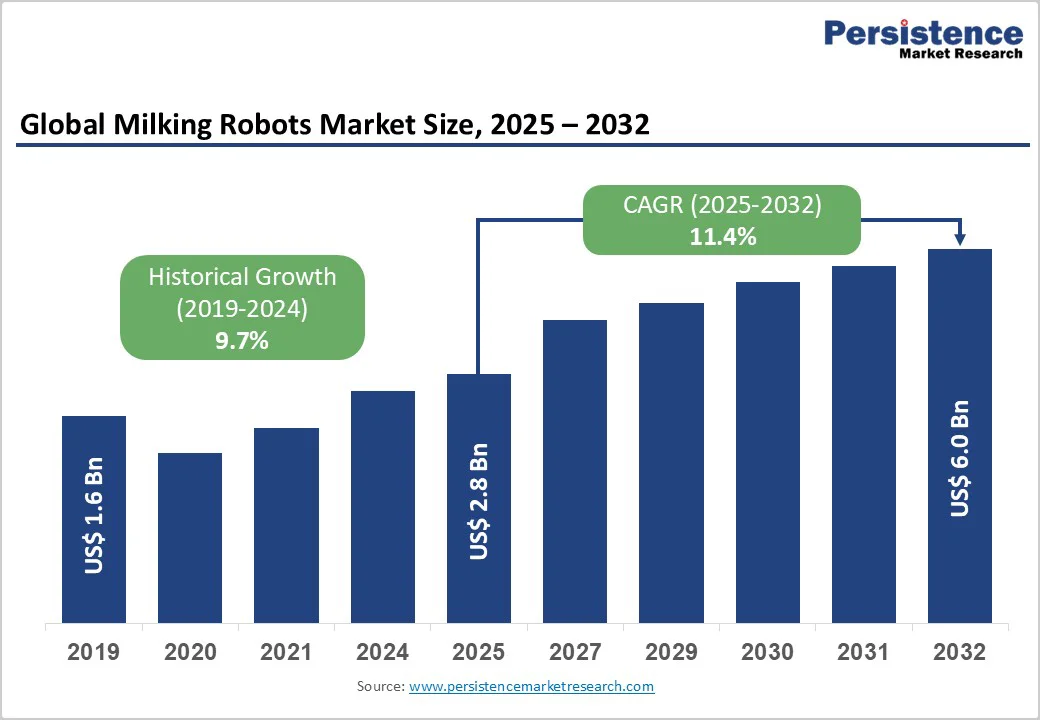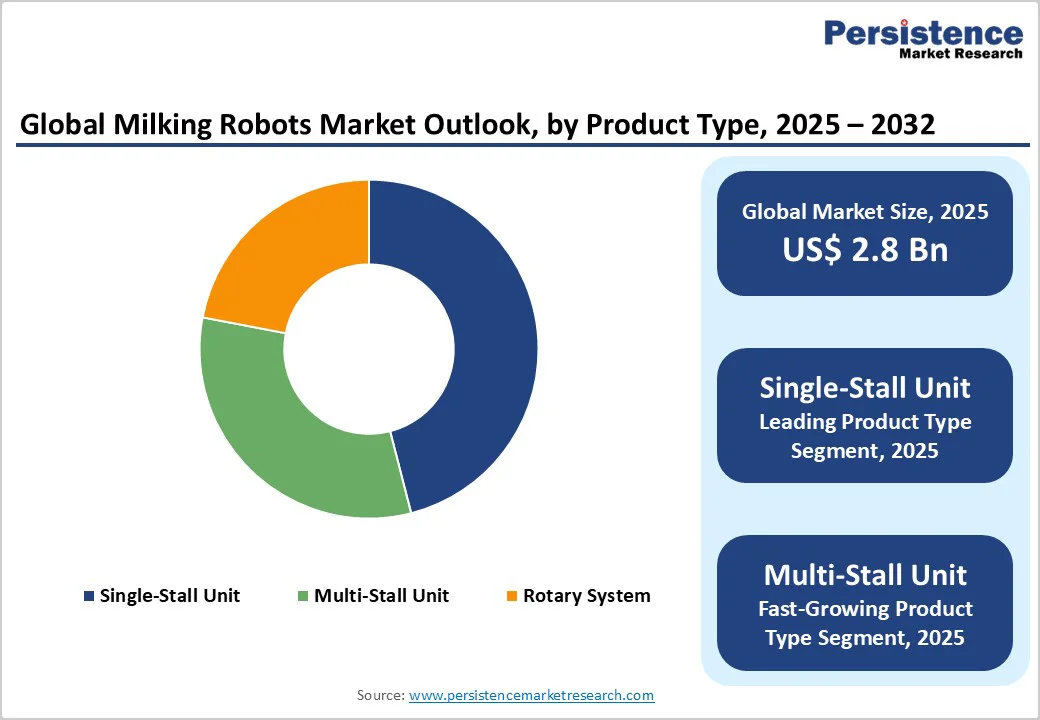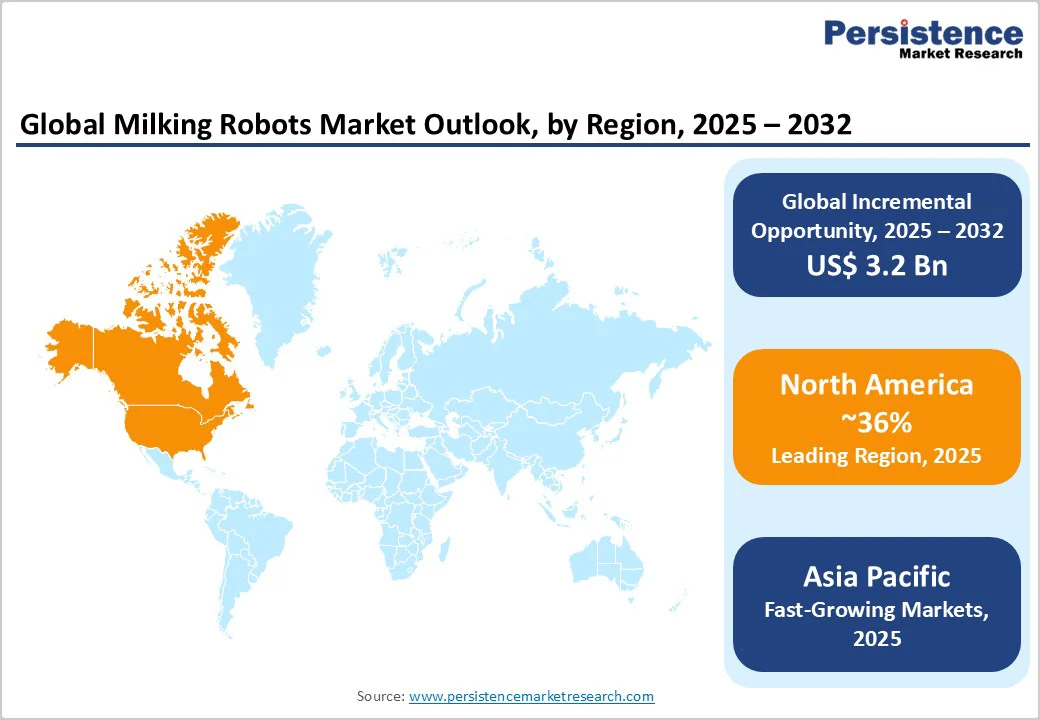ID: PMRREP32599| 210 Pages | 12 Dec 2025 | Format: PDF, Excel, PPT* | Semiconductor Electronics

The global milking robots market size is valued at US$2.8 billion in 2025 and projected to reach US$6.0 billion by 2032, growing at a CAGR of 11.4% between 2025 and 2032. The market expansion is fundamentally driven by severe labor shortages in dairy farming regions globally. Rising demand for dairy products, coupled with technological advancements in sensor integration and artificial intelligence-powered herd management systems, creates compelling drivers for sustained market growth.
| Key Insights | Details |
|---|---|
|
Milking Robots Market Size (2025E) |
US$2.8 billion |
|
Market Value Forecast (2032F) |
US$6.0 billion |
|
Projected Growth CAGR(2025-2032) |
11.4% |
|
Historical Market Growth (2019-2024) |
9.7% |

The dairy industry faces an unprecedented labor crisis that is accelerating milking robot adoption across North America, Europe, and the Asia-Pacific region. According to comprehensive employment data, farm employment declined by 3.4% between March 2024 and April 2025, while agricultural labor costs rose to more than US$53 billion in 2025. In the United States, 51% of dairy workers are immigrants, and over 79% of national milk production is dependent on immigrant-staffed farms, creating vulnerability to policy changes and workforce disruptions. Wisconsin exemplifies this crisis, relying on approximately 70% immigrant labor, with more than 10,000 undocumented workers performing essential dairy operations.
United Kingdom surveys reveal that over 50% of farmers experienced difficulty recruiting staff over the preceding five years, with nearly 9% of dairy operations reducing milk production due to workforce shortages. Milking robots address this critical constraint by reducing labor requirements by up to 60%, with 18-month return on investment timelines versus the traditional 4-10-year paybacks of conventional milking systems. Major dairy operations, including Miltrim Farms in the United States with 1,800 cows, successfully implemented 30 box barn milking robots without increasing labor needs, maintaining operations with only six full-time employees despite expanding the herd by 1,200 animals.
Global milk production continues to expand to meet rising consumer demand, particularly in Asia-Pacific markets, where government initiatives actively promote dairy modernization and food safety improvements. India maintains its position as the world's leading milk producer, generating 24% of the global milk supply, with a remarkable 61% growth in milk production over eight years. China's dairy industry continues to expand rapidly despite self-sufficiency rates fluctuating between 70% and 80%, necessitating increases in production through advanced farming technologies. Milking robots significantly enhance productivity by enabling frequent milking sessions that increase milk yield, with automated systems capable of milking 65-70 dairy animals multiple times daily.
Advanced sensor technologies integrated into robotic systems provide comprehensive herd health monitoring, real-time detection of mastitis through conductivity analysis, and predictive analytics for preventive animal care. Individual cow identification and data tracking enable precision management of lactation cycles, feed optimization, and genetic improvement through daily monitoring of milk components. Single-stall systems can efficiently serve herds of approximately 60-70 cows, while multi-stall robots with four units manage herds exceeding 160 animals, enabling scalability across diverse farm sizes. The integration of artificial intelligence with sensor data transforms raw production information into actionable management insights, improving overall farm profitability through optimized resource allocation.
Milking robot systems require substantial upfront capital, posing adoption challenges for small- and mid-sized dairy farms with limited financial resources. Single-stall units typically cost between US$200,000 and US$300,000, while multi-stall systems for large herds can exceed US$500,000. Additional expenses include barn modifications, electrical infrastructure upgrades, and data integration platforms, often doubling total implementation costs.
Operating these systems requires specialized personnel training, and early adoption phases can see temporary declines in milk yield and operational inefficiencies. Return-on-investment timelines of 4–10 years create significant financial barriers, particularly for farms with constrained access to credit or existing debt obligations, limiting broader adoption despite the potential for long-term labor savings, improved herd management, and enhanced productivity.
Robotic milking systems require careful cow adaptation to voluntary movement patterns and autonomous teat attachment, with transition periods of 2–4 weeks often resulting in reduced milk yield. Individual cow behavior and temperament introduce variability in system efficiency, making herd management more complex during early implementation. Advanced robotic hardware, multiple sensors, and software platforms demand skilled maintenance, troubleshooting, and timely access to replacement parts. Integration with existing herd management and farm automation systems can create software compatibility and cybersecurity challenges.
Environmental factors, including temperature extremes, humidity, and dust accumulation, can affect mechanical reliability and sensor performance. Limited availability of qualified technicians in certain regions further constrains adoption, emphasizing the need for robust service networks and ongoing technical support.
Small-scale dairy farms, managing 50–100 animals, are increasingly adopting single-stall robotic milking systems due to affordability, minimal infrastructure requirements, and operational flexibility. Emerging markets, particularly India and Southeast Asia, are witnessing accelerated uptake driven by government mechanization incentives, subsidies, and modernization programs. China’s dairy modernization initiatives are expected to sustain steady growth, while India anticipates rapid expansion through 2032, fueled by improved livestock management practices. Technological democratization and local manufacturing advancements make robotic systems accessible to small- and mid-sized farms, enabling labor optimization, productivity enhancement, and operational efficiency. These trends support broader automation adoption, facilitating sustainable and regenerative agriculture practices and empowering small farmers to implement precision dairy farming practices that were previously limited to large commercial operations.
The integration of AI, machine learning, and advanced data analytics with milking robots drives precision livestock farming and herd management optimization. Smart robotic systems provide actionable insights for reproductive monitoring, health detection, milk composition analysis, and behavioral tracking. Collar-based sensors, such as Afimilk’s solutions, enable early identification of heat cycles, illnesses, and productivity deviations.
At the same time, inline milk analysis detects conditions like ketosis and subclinical mastitis in real time. Integration with automated feeding, sorting gates, and farm management platforms reduces labor dependence and optimizes resource utilization. These capabilities enhance milk quality, improve operational efficiency, and minimize environmental impact, supporting sustainability goals and delivering competitive advantages to technologically advanced dairy operations worldwide.
Single-stall units dominate the global milking robots market with approximately 46% share in 2025, driven by adoption across North American and European farms seeking cost-effective, minimally disruptive automation. These units integrate seamlessly into existing barn infrastructure, requiring minimal renovations while providing flexible, autonomous milking of 65–70 cows multiple times daily. Advanced electrical conductivity technology ensures efficient milk collection and real-time herd health monitoring, supporting decision-making on reproduction, nutrition, and disease detection. Operational simplicity allows farm personnel with limited technical expertise to manage these systems effectively. Their scalability, affordability, and compatibility with conventional parlor operations make single-stall units the preferred choice for small- and medium-sized farms transitioning toward automation.
Small farms managing 50–100 animals represent the largest herd-size segment with approximately 43% global market share in 2025, driven by labor shortages and limited human resource capacity. Robotic systems tailored to small-scale operations enable cost-efficient automation without unnecessary excess capacity or capital expenditure. Entry-level single-stall robots incorporate affordable sensor technology and simplified management interfaces, supporting productivity and herd monitoring while minimizing operational complexity. This segment’s prominence reflects the predominance of small- to mid-sized farms globally, which, despite producing lower total milk volumes, require automation solutions to maintain consistent milk yield, optimize labor efficiency, and reduce reliance on seasonal or migrant labor.
Fixed milking systems lead the operations category with approximately 54% market share in 2025, characterized by permanently installed robots integrated into barn infrastructure. These systems offer maximum operational reliability, advanced sensor integration, and comprehensive data monitoring for herd health, milk quality, and facility management. Their established adoption across conventional dairy operations ensures robust service support and farmer familiarity, promoting continued preference for stationary installations. Fixed systems’ long-term integration facilitates consistent milk production, enhanced herd monitoring, and optimized operational workflows, solidifying their position as the cornerstone of automated dairy farm operations worldwide.

North America's milking robots market is expected to account for approximately 36% of the market in 2025, driven by chronic labor shortages, advanced dairy infrastructure, and strong farmer investment capacity. In the United States, immigrant workers comprise 51% of the dairy workforce, produce 79% of milk, and are highly vulnerable to labor disruptions, accelerating automation adoption. States like Wisconsin, Kansas, and California are seeing significant investments in robotic milking, with productivity gains supporting milk production growth and cost reductions.
Rising labor costs and a 3.4% farm employment decline between March 2024 and April 2025 underscore financial incentives for mechanization. Canada mirrors these trends with similar labor dynamics and regulatory frameworks encouraging automation adoption. Government incentives for farm technology investment, supportive credit mechanisms from financial institutions, and a thriving technology ecosystem for component manufacturing further drive adoption of advanced robotic milking systems, enabling operational efficiency, traceability, and compliance with food safety standards.
Europe holds around one-third of the global milking robots market in 2025, led by Germany, the UK, France, and Spain, where high labor costs and strict workforce regulations drive automation. Germany, Europe’s largest agricultural market, invests heavily in robotic systems, supporting manufacturers like DeLaval and GEA. Emerging markets, such as the Czech Republic, showcase large-scale implementations, exemplified by Uhelná Príbram’s 50-stall GEA DairyProQ rotary system, milking over 1,100 cows daily.
Labor shortages in the UK compel automation adoption, with many farms reducing output due to workforce constraints. EU sustainability directives promoting efficiency, reduced carbon footprint, and animal welfare encourage robotic milking deployment. Advanced technologies, including DeLaval’s VMS Batch Milking, facilitate large-herd automation while maintaining operational familiarity. Harmonized regulations across member states support standardization, service infrastructure development, and component interoperability, ensuring seamless integration of robotic systems across diverse European dairy operations.
Asia Pacific is the fastest-growing milking robots market, projected to exceed a 16% CAGR from 2025 to 2032, led by India, China, and emerging economies. India, the world’s largest milk producer, drives mechanization adoption in small-scale farms through affordable single-stall robotic solutions and supportive government initiatives promoting automation. China’s modernization programs emphasize large-scale dairy farms, food safety, and digital transformation, with automation adoption concentrated in Inner Mongolia and Heilongjiang, projecting double digit growth through 2032.
Established markets like Australia and New Zealand focus on precision dairy farming integrating automatic milking with herd health monitoring, supported by partnerships such as Milking Edge with DeLaval. South Korea’s advanced agricultural sector also embraces robotics to improve labor efficiency. Government incentives, technological advancements, and growing awareness of productivity and animal welfare benefits underpin sustained adoption of robotic milking systems throughout the region.

The global milking robots market is moderately consolidated, with established multinational agricultural equipment manufacturers coexisting alongside specialized robotics innovators. Lely Holding S.A.R.L. leads with over 50,000 Astronaut units installed worldwide, reflecting three decades of continuous innovation. DeLaval drives large-herd efficiency through its VMS Batch Milking systems, combining robotic precision with familiar operational workflows. GEA Group offers DairyProQ rotary automated milking solutions for performance-oriented large farms, emphasizing modular design for uninterrupted operations.
BouMatic Robotics focuses on cow comfort, high throughput, and actionable data insights, while Waikato Milking Systems LP delivers region-specific solutions across Asia Pacific. Afimilk Ltd. differentiates through advanced sensors and predictive analytics for herd health management, and Dairymaster emphasizes sustainability and resource efficiency. Market competition increasingly centers on integrated hardware-software solutions, AI-powered analytics, and connectivity features enabling remote monitoring and autonomous farm management, with leading players prioritizing product innovation and regional penetration over aggressive mergers or acquisitions.
The Milking Robots Market is valued at US$ 2.8B in 2025, projected to reach US$ 6.0B by 2032, growing at 11.4% CAGR due to labor shortages, milk demand, and precision livestock adoption.
Key drivers include labor shortages, high farm costs, rising milk demand in Asia Pacific, AI and sensor advancements, and mechanization incentives.
Single-Stall Units with 46% share in 2025 lead due to cost-effectiveness, flexibility, minimal infrastructure needs, and milking 65–70 cows’ multiple times daily.
Asia Pacific with 16% CAGR between 2025-2032 is the fastest growing region, driven by dairy expansion, government incentives, and adoption of affordable robotic solutions.
Integration with AI-powered Precision Livestock Farming for herd health, feed optimization, and reproductive management is the largest opportunity.
Lely, DeLaval, GEA, BouMatic, Afimilk, Waikato Milking Systems, and Fullwood lead through innovation, service, and herd management integration.
| Report Attribute | Details |
|---|---|
|
Historical Data/Actuals |
2019 - 2024 |
|
Forecast Period |
2025 - 2032 |
|
Market Analysis Units |
Value: US$ Mn/Bn, Volume: As Applicable |
|
Geographical Coverage |
|
|
Segmental Coverage |
|
|
Competitive Analysis |
|
|
Report Highlights |
|
By Product Type
By Herd Size
By Mode of Operations
By Region
Delivery Timelines
For more information on this report and its delivery timelines please get in touch with our sales team.
About Author